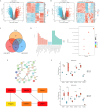Exploring the mechanism of rosmarinic acid in the treatment of lung adenocarcinoma based on bioinformatics methods and experimental validation
- PMID: 39812944
- PMCID: PMC11735722
- DOI: 10.1007/s12672-025-01784-0
Exploring the mechanism of rosmarinic acid in the treatment of lung adenocarcinoma based on bioinformatics methods and experimental validation
Abstract
Objective: Rosmarinic acid (RosA) is a natural polyphenol compound that has been shown to be effective in the treatment of inflammatory disease and a variety of malignant tumors. However, its specific mechanism for the treatment of lung adenocarcinoma (LUAD) has not been fully elucidated. Therefore, this study aims to clarify the mechanism of RosA in the treatment of LUAD by integrating bioinformatics, network pharmacology and in vivo experiments, and to explore the potential of the active ingredients of traditional Chinese medicine in treating LUAD.
Methods: Firstly, the network pharmacology was used to screen the RosA targets, and LUAD-related differential expressed genes (DEGs) were acquired from the GEO database. The intersection of LUAD regulated by RosA (RDEGs) was obtained through the Venn diagram. Secondly, GO and KEGG enrichment analysis of RDEGs were performed, and protein-protein interaction networks (PPIs) were constructed to identify and visualize hub RDEGs. Then, molecular docking between hub RDEGs and RosA was performed, and further evaluation was carried out by using bioinformatics for the predictive value of the hub RDEGs. Finally, the mechanism of RosA in the treatment of LUAD was verified by establishing a xenograft model of NSCLC in nude mouse.
Results: Bioinformatics and other analysis showed that, compared with the control group, the expressions of MMP-1, MMP-9, IGFBP3 and PLAU in LUAD tissues were significantly up-regulated, and the expressions of PPARG and FABP4 were significantly down-regulated, and these hub RDEGs had potential predictive value for LUAD. In vivo experimental results showed that RosA could inhibit the growth of transplanted tumors in nude mice bearing tumors of lung cancer cells, reduce the positive expression of Ki67 in lung tumor tissue, and hinder the proliferation of lung tumor cells. Upregulated expression of PPARG and FABP4 by activating the PPAR signaling pathway increases the level of ROS in lung tumor tissues and promotes apoptosis of lung tumor cells. In addition, RosA can also reduce the expression of MMP-9 and IGFBP3, inhibit the migration and invasion of lung tumor tissue cells.
Conclusions: This study demonstrated that RosA could induce apoptosis by regulating the PPAR signaling pathway and the expression of MMP-9, inhibit the proliferation, migration and invasion of lung cancer cells, thereby exerting anti-LUAD effects. This study provides new insight into the potential mechanism of RosA in treating LUAD and provides a new therapeutic avenue for treatment of LUAD.
Keywords: Apoptosis; Bioinformatics; Lung adenocarcinoma; MMP-9; PPAR signaling pathway; Rosmarinic acid.
© 2025. The Author(s).
Conflict of interest statement
Declarations. Ethics approval and consent to participate: This study was approved by the Ethics Review Committee of Hunan Provincial Key Laboratory of Traditional Chinese Medicine Diagnostics. All animal experimental procedures were carried out following the Hunan University of Chinese Medicine Animal Experimentation Ethics Guidelines (Approval Number: LL2023051801). This study is reported in accordance with the ARRIVE guidelines, and all subcutaneous tumors in mice were less than 20 mm in diameter, meeting IRB criteria. Competing interests: The authors declare no competing interests.
Figures







Similar articles
-
Exploring the mechanism of 6-Methoxydihydrosanguinarine in the treatment of lung adenocarcinoma based on network pharmacology, molecular docking and experimental investigation.BMC Complement Med Ther. 2024 May 23;24(1):202. doi: 10.1186/s12906-024-04497-z. BMC Complement Med Ther. 2024. PMID: 38783288 Free PMC article.
-
Molecular and metabolic mechanisms of bufalin against lung adenocarcinoma: New and comprehensive evidences from network pharmacology, metabolomics and molecular biology experiment.Comput Biol Med. 2023 May;157:106777. doi: 10.1016/j.compbiomed.2023.106777. Epub 2023 Mar 11. Comput Biol Med. 2023. PMID: 36924737
-
A real-world study and network pharmacology analysis of EGFR-TKIs combined with ZLJT to delay drug resistance in advanced lung adenocarcinoma.BMC Complement Med Ther. 2023 Nov 21;23(1):422. doi: 10.1186/s12906-023-04213-3. BMC Complement Med Ther. 2023. PMID: 37990309 Free PMC article.
-
Exploring the Mechanism of Zilongjin in Treating Lung Adenocarcinoma Based on Network Pharmacology Combined with Experimental Verification.Crit Rev Immunol. 2024;44(5):27-40. doi: 10.1615/CritRevImmunol.2024051316. Crit Rev Immunol. 2024. PMID: 38618726
-
The identification of key biomarkers in patients with lung adenocarcinoma based on bioinformatics.Math Biosci Eng. 2019 Aug 21;16(6):7671-7687. doi: 10.3934/mbe.2019384. Math Biosci Eng. 2019. PMID: 31698633
References
-
- Siegel RL, Giaquinto AN, Jemal A. Cancer statistics, 2024. CA Cancer J Clin. 2024. 10.3322/caac.21820. - PubMed
Grants and funding
LinkOut - more resources
Full Text Sources
Research Materials
Miscellaneous
